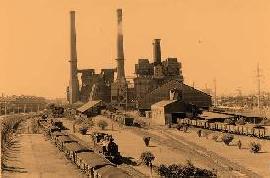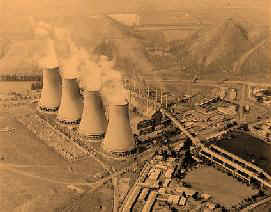The years of suffering - "Into the darkness"
The extra supply came in handy, for although electricity demand dipped in 1943 (for only the second time in ESCOM’s history) by 1944, when an Allied victory seemed certain, demand increased by 3.3% and by 6.6% the following year. Indeed fuel and spare parts shortages (during the first part of the war) had placed strain on the system, and ESCOM was hard pressed to meet demand and had to rely on small generators belonging to ISCOR, municipalities, and even the Rand Water Board to keep the system running.
In January 1945 Vaal power station began producing electricity. This power station was built to “feed into the grid system of the Commission and the Victoria Falls and Transvaal power Company, Limited” (1938 Annual Report, pg. 6). While it did indeed contribute to the Rand network, it also supplied much needed power to new goldfields that were springing up in the Free State.
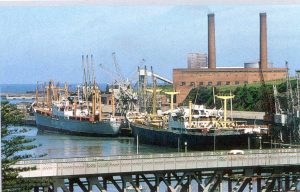
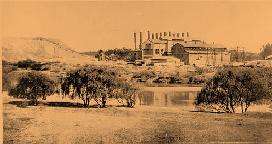
In 1948 ESCOM’s finances were in good shape to effect the long anticipated expropriation of the VFP. ESCOM’s capital stood at over £30m, and total assets exceeded total liabilities by more than £10m. There was one major problem to overcome though; the exact expropriation date was in dispute. The 1922 Electricity Act was ambiguous, and depending on how the law was interpreted the date could range from November 1947 to November 1950. Dr van der Bijl was keen to expedite the expropriation and directly appealed to Prime Minister Smuts in a 1944 letter arguing that early expropriation would save the gold mines £2m per year. Smuts was unmoved and restated the government’s opinion that the later date was the correct one. The gold mining industry had also done their sums, and was behind van der Bijl in his quest for early expropriation. In January 1947 Sir Ernest Oppenheimer, chairman of Anglo American, wrote to Dr van der Bijl urging him to expedite the expropriation. He even offered some shrewd advice: “Make an offer to the shareholders at a price slightly above the ruling market price: I have a hunch that this would be cheaper than dealing with [Bernard] Price.”
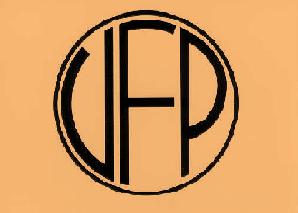
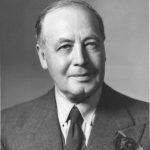
Albert Jacobs, (AM Jacobs.jpg) ESCOM’s chief engineer and a Commissioner since 1926, took over as chairman at the beginning of 1949. After the end of the war ESCOM was faced with a dual challenge: strong industrial demand within South Africa, and worldwide shortages in power station plant equipment. In 1949 the Rand Undertaking – an area which accounted for some 80% of South Africa’s wealth – experienced severe constraints, and ESCOM consulted with the Chamber of Mines to come up with a quota system and emergency rules whereby interruptions could be avoided. Meanwhile ESCOM was furiously planning and designing new power stations, as well as upgrading current stations. Capital was needed for an ambitious expansion programme, and in 1951 ESCOM secured a $30m loan from the International Bank for reconstruction and development. The money would help beef up capacity at existing plants as well as pay for the seven new plants that were on order or in the advanced stages of planning.
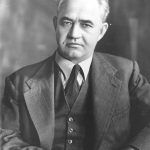
Problems with plant maintenance caused great concern. Machinery in use since ESCOM was established had to endure years of excessive use. ESCOM staff displayed ingenuity in expanding the electricity distribution system. During World War II, the Director-General of War Supplies ordered ESCOM to undertake the manufacture of instrumentation and parts for sophisticated weapons at its Rosherville workshop. A steel shortage caused ESCOM to build reinforced concrete pylons to support overhead high-voltage lines. These uncommon pylons were erected in Orange Free State (now known simply as Free State), Natal (now known as KwaZulu-Natal) and Eastern Transvaal (now known as Mpumalanga).
World War II caused the commissioning of Vaal power station to be delayed. It was finally on stream by 1952. ESCOM had to dop without essential equipment due to the crippling of commercial shipping. A ship carrying a trubo-generator set destined for Congella power station was torpedoed by a German submarine. Various projects had to be postponed indefinitely.
In this period, power sales declined until the war turned in favour of the Allied Forces. In 1946, ESCOM had increased its annual sales to 5 000 million units. Despite the long-awaited peace conditions, ESCOM was greatly handicapped by the shortage of generation and distribution equipment. This delayed the erection of new power stations and taxed the capability of existing installations to respond to the high demand for electrical power. Demand from new gold fields in the Orange Free State, and applications from towns, mines and industries for electrical power supply, led to the expansion of ESCOM’s licenced area by 41 000 square kilometres.
ESCOM acquired the Port Shepstone power station in 1944. In 1947, ESCOM took over the running of West Bank power station at the request of the East London municipality. At an ESCOM meeting in 1947, it was decided to take over the central power station of De Beers mines in Kimberley. ESCOM purchased the World War II caused the commissioning of Vaal power station to be delayed. It was finally on stream by 1952. ESCOM had to do without essential equipment due to the crippling of commercial shipping. A ship carrying a turbo-generator set destined for Congella power station was torpedoed by a German submarine. Various projects had to be postponed indefinitely. Alice and King William’s Town municipal undertakings in 1948. All this resulted in the establishment of the Border and Northern Cape undertakings.
In accordance with conditions first stipulated in the Power Act of 1910 and included in the Electricity Act of 1922, all assets of the VFP were expropriated and taken over by ESCOM in 1948. ESCOM inherited a well-planned and properly established VFP power system. A new Rand undertaking was formed. Extensions to existing power stations at Colenso, Congella, Rosherville, Vaal, Witbank, West Bank and Kimberley Central were undertaken.
ESCOM’s founding Chairman, Dr H J van der Bijl, died in December 1948. Mr A M Jacobs, previously ESCOM’s Chief Engineer and Technical Officer, succeeded Dr Van der Bijl as Chairman of ESCOM.

